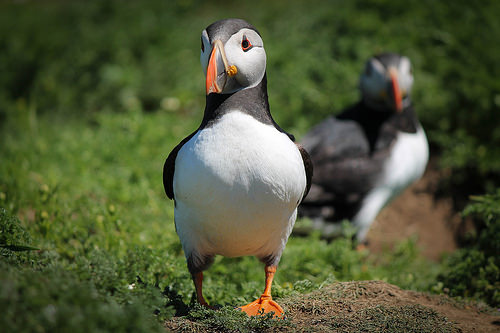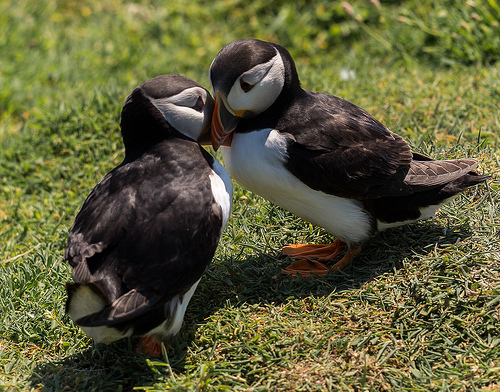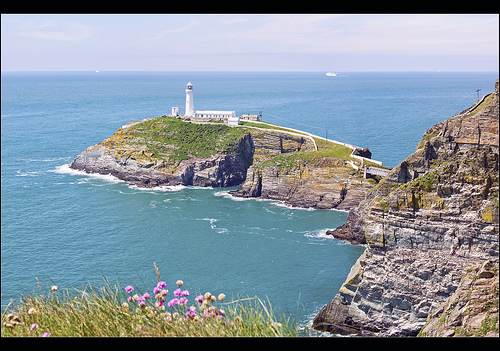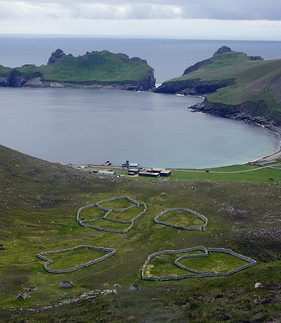We do too. But do you want to go out and see them?
Show me Wild ExperiencesKeep up to date with the hottest wildlife content on the web and save £10 on your first wildlife experience.
Sign Me Up!
Puffin on Skomer Island
The Atlantic puffin is one of the most recognisable seabirds all over the world because of its colourful beak. From dull grey during winter, the beak comes to life in spring as it turns into bright orange, yellow and blue. It is believed that this shift to bold colours is primarily meant to attract mates. Their technicolour beaks resemble that of parrots which is why the puffin is sometimes referred to as ‘sea parrot’.
Apart from their brightly coloured beaks, Atlantic puffins have eyes which are surrounded by black and orange markings. Moreover, their legs and feet are a bright shade of orange. The bold hues on their body earned them another nickname – ‘clowns of the sea’. Meanwhile, their body colour is similar to that of penguins - white chest and belly and black back, tail and upper wings.
As mentioned earlier, their colourful beaks are meant to attract mates. During courtship, they engage in billing – an act wherein puffins rub and clack their bills together. Puffin breeding season is usually during spring and summer months. Each year, puffins breed with the same partner and the female puffins only lay a single egg. Both male and female help each other in incubating the egg.

Puffins billing
Puffins can swim and fly. Enabling them to become excellent swimmers are their wings and webbed feet. They are also capable of diving to depths of 60 metres but cannot stay underwater for over 30 seconds. When it comes to flying, they can travel at a speed of 88 kilometres per hour with the aid of their wings which can flap 400 times in one minute. Their diet is primarily composed of small fish like sand eels and herring.
Global population of Atlantic puffin is on a decline. In the UK, puffins have been on the “red list” since 2015 with major colonies showing big drop in numbers. Shortage in food supply due to climate change is believed to be one of the major reasons in their dropping numbers.
Despite their declining population, these so-called sea parrots are still seen in several places in Britain. Below are some of the puffin hot spots in the UK. Just make sure to visit between March and July to get the most out of your experience.
Where Can You See Puffins in the UK?
The three best places to spot or watch puffins in the UK are in Skomer Island, South Stack Cliffs and St. Kilda.
Skomer Island
Located in Wales off the coast of Pembrokshire, Skomer Island is a wildlife haven with its diverse flora and fauna. But if there’s an animal that it is well-known for, it is the puffin. During April, you can witness the arrival of these colourful seabirds on the island. You may spot them standing beside their burrows, flying in with fish in their mouth or billing. There are plenty of good spots for puffin-watching on the island; all you have to do is pick one. Lastly, getting up close and personal with puffins is not impossible at Skomer Island. You can stand just a few metres from them! They may even walk right past you!
Aside from puffins, you may see other seabirds like gannets and Manx Shearwater. In fact, seabirds are common on Skomer Island’s skyline. Meanwhile, the surrounding clear, blue sea is a playground for porpoises and dolphins and the beach is for a colony of Atlantic grey seals.
Since it is a very famous destination, Skomer Island has high foot traffic, especially during the peak months (May-July). So, make sure you plan your visit accordingly and arrive at the place early to ensure that you get tickets.

South Staff Cliffs
South Stack Cliffs
South Stack Cliffs is another place in Wales where you could see puffins. It is located off Holy Island on the coast of Anglesey. This is actually a reserve that features views of enchanting cliffs, lush farmlands and vast ocean.
The cliffs, in particular, serve as nesting places for thousands of seabirds including the puffins. Aside from puffins, other seabirds found on South Stack Cliffs are the guillemots and razorbills. This place is an important breeding place for choughs as well. The sight of thousands of puffins and other seabirds on the cliff can be mesmerising. So, make sure you bring a camera with you.
There is no public transport servicing South Stack Cliffs. The best way to reach the place is to ride a cab or bring your own car. The place is open all year round from 10 AM to 5 PM. Make sure to dress appropriately, especially during the rainy season for a pleasant and memorable visit.

St. Kilda
St. Kilda
The largest colony of puffins in Scotland (and the country) can be found in St. Kilda. Their number on this World Heritage Site accounts for a quarter of the entire European population. Currently, there are an estimated 250,000 puffins on St. Kilda.
In Scotland, these colourful seabirds are called ‘Tammie Norries’. They lay their eggs on the grassy slopes atop the cliff. Puffins can be seen on the ‘stacks’, the giant rocks behind the main island. For better view, you can ride a boat and circle the ‘stacks’ and watch puffins waddling or flying. While you may not encounter them up close, seeing their huge number is exhilarating enough.
Admittedly, travelling to St. Kilda is not easy as the waters can be rough and weather conditions can be harsh. Yet, if you are up for some adventure, there are day trip boats at the Western Isles and Skye. There are also big cruise ships that dock on St. Kilda yearly. Alternatively, if you have your own yacht or boat, you may travel using your own transport provided that you inform those managing St. Kilda ahead of time. The best time to visit is from May to June, when the weather is most reliable.
If seeing puffins is on your bucket list, these three are the best places in the UK to spot them. Just make sure that when you visit puffin colonies, you avoid disturbing their nesting sites. It’s also best to keep a safe distance from these nests. Move slowly and quietly so as not to disturb them and drive them away. Most importantly, never get in the way of parents carrying food for their young.
—
Puffin on Skomer Island photo by photographating
Puffins billing photo by Sugarmonster
South Stack Cliffs photo by Bert Kaufmann
St. Kilda photo by CaptainOates